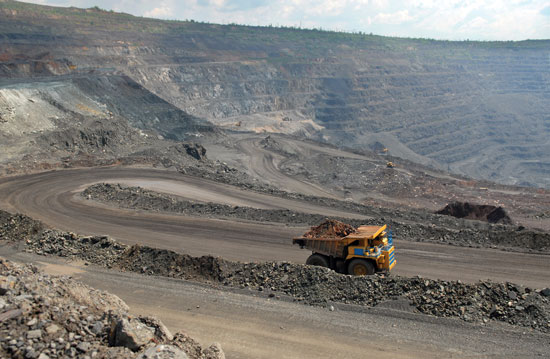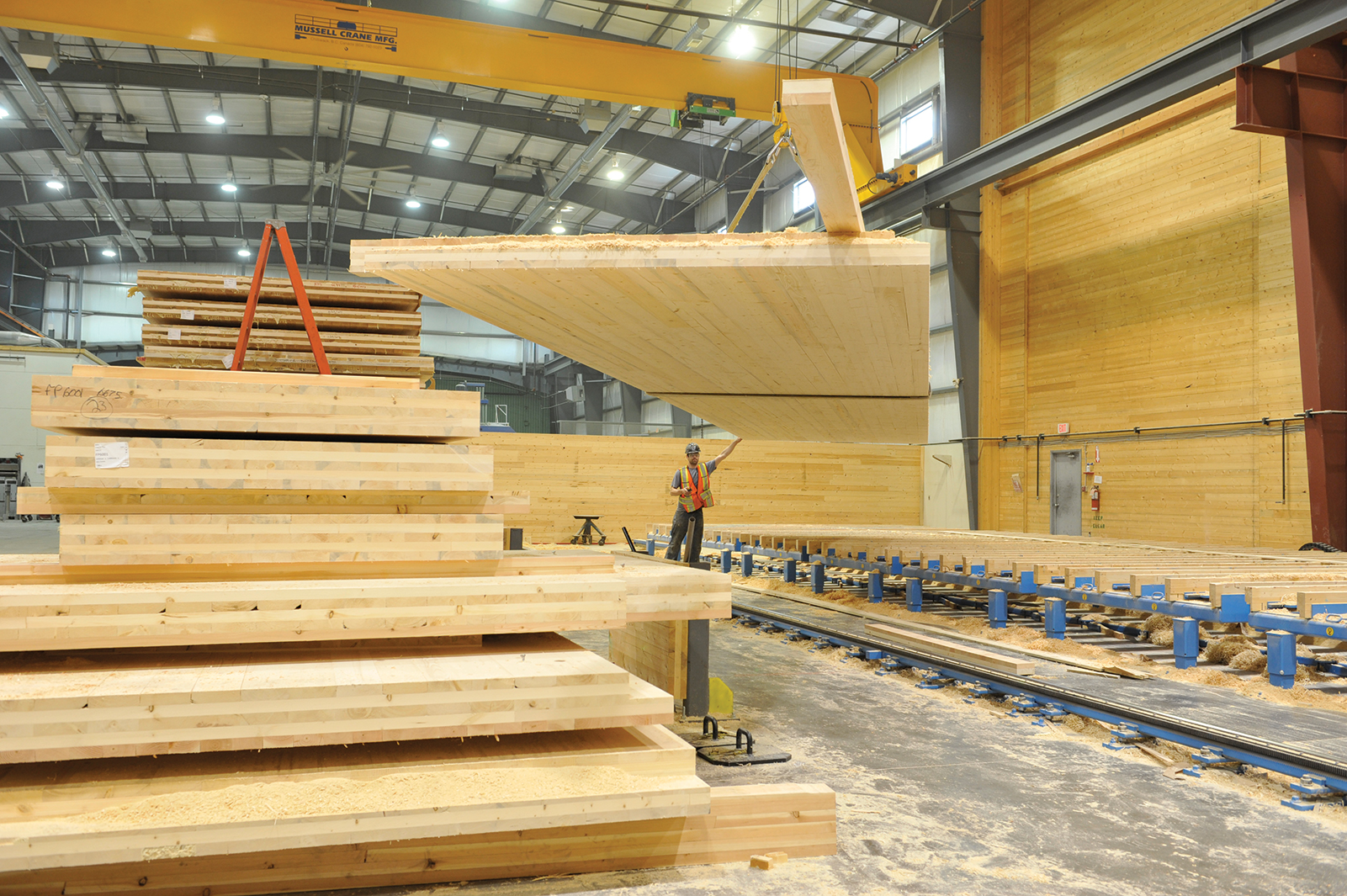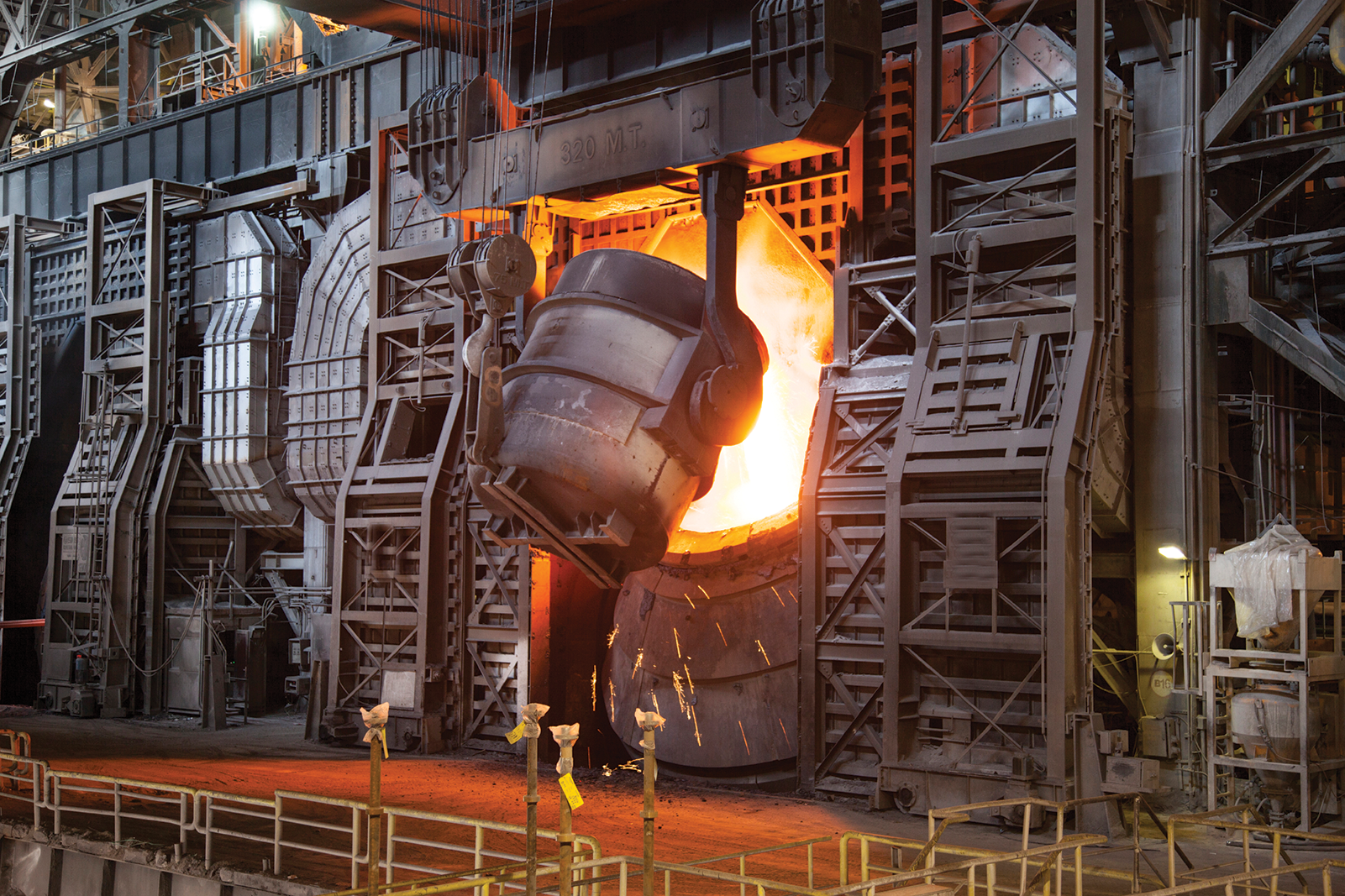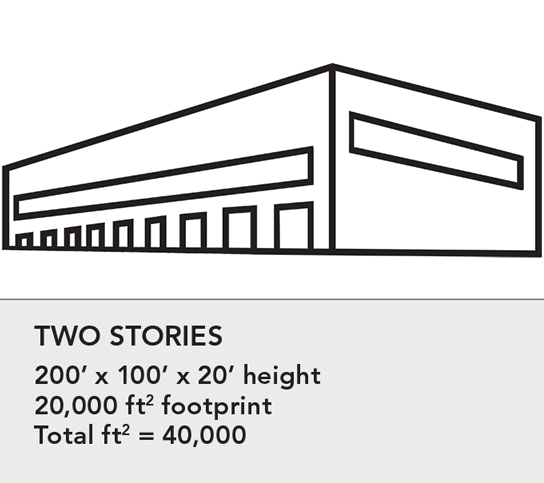This CE Center article is no longer eligible for receiving credits.
From an environmental perspective, it is widely known that buildings matter. Buildings consume nearly half the energy produced in the United States, use three-quarters of the electricity and account for nearly half of all carbon dioxide (CO2) emissions.1 The magnitude of their effects is the driving force behind many initiatives to improve tomorrow’s structures—from energy regulations and government procurement policies, to green building rating systems and programs such as the Architecture 2030 Challenge. The focus on energy efficiency, in particular, has led to widespread improvements, so much so that many designers are now giving greater attention to the impacts of structural building materials.
With an abundance of information and competing environmental claims, determining a material’s true impacts can be a challenge. Does wood reduce a building’s carbon footprint in a meaningful way? Is it better to use recycled steel or wood from a sustainably managed forest? To what extent do structural materials impact operational performance? Does resilience depend on the material or on proper design and maintenance?
This course seeks to address these and other questions. Examining materials throughout their life cycles, it focuses on international research supporting the use of wood for its carbon and other benefits while considering some of the advantages of concrete and steel. It also touches on the efforts by all three industries to lessen their environmental impacts. The reality is that no one material is the best choice for every application. There are trade-offs associated with each, and each has benefits that could outweigh the others based on the objectives of a project.

Clay Creative | Architect: Mackenzie | Photo: Christian Columbres
Importance of a Life-Cycle View
Understanding a material’s impact at every stage of its life is essential for designers looking to compare alternate designs or simply make informed choices about the products they use. Life-cycle assessment (LCA) is an internationally recognized method for measuring the environmental impacts of materials, assemblies or whole buildings, from extraction or harvest of raw materials through manufacturing, transportation, installation, use, maintenance, and disposal or recycling.
LCA is sometimes described as mysterious and complicated. Yet what is involved is simply a thorough accounting of resource consumption, including energy, emissions, and wastes associated with production and use of a product. For a “product” as complex as a building, this means tracking and tallying inputs and outputs for all assemblies and subassemblies—every framing member, panel, fastener, finish material, coating and so on. To ensure that results and data developed by different LCA practitioners and in different countries are consistent, LCA practitioners must adhere to a set of international guidelines set forth by the International Organization for Standardization (ISO).
The use of LCA in North America is increasing due in part to the availability of easy-to-use and affordable tools (see sidebar, "Calculating the Impacts of Building Designs"). LCA is also included in all of the major green building rating systems, providing an alternative to the “prescriptive approach” to material selection. This approach assumes that certain prescribed practices, such as specifying products with recycled content, are better for the environment regardless of the product’s manufacturing process or disposal. It was a cornerstone of early green building efforts, when there was relatively little information available on the impacts of individual products at different life-cycle stages.
LCA studies consistently demonstrate wood’s environmental advantages. For example, one literature review examined all of the available research from North America, Europe and Australia pertaining to the life-cycle assessment of wood products.2 It applied LCA criteria in accordance with ISO 14040-42 and concluded, among other things, that:
- Fossil fuel consumption, the potential contributions to the greenhouse effect and the quantities of solid waste tend to be minor for wood products compared with competing products.
- Wood products that have been installed and are used in an appropriate way tend to have a favorable environmental profile compared with functionally equivalent products made from other materials.
The table below illustrates the results of an LCA comparing a simple commercial structure designed in wood, steel and concrete. Designed for the Atlanta geographical area, the building footprint was 20,000 square feet (100 feet by 200 feet). The structure is two stories in height and 20 feet tall, with 40,000 square feet of total floor area. To simplify analysis, the theoretical building was analyzed without windows, doors or internal partitions. All three configurations were assumed to have a concrete foundation and slab.
The analysis involved systematic assessment, using life-cycle methodology, of all building assemblies beginning with raw material extraction through primary and secondary manufacturing, transport at all stages of the production chain and to the job site, and building construction. As shown in the table, impacts for the wood design are lower than either the steel or concrete design across all indicators.

Source: Athena EcoCalculator
Carbon Footprint: Reducing Greenhouse Gases
Although there is growing awareness that using wood from sustainably managed forests can reduce a building’s carbon footprint, only a portion of wood’s benefits are recognized in an LCA. As noted, the LCA literature review concluded that fossil fuel consumption and potential contributions to the greenhouse effect tend to be minor for wood products compared with competing products. This is because wood products require less energy to manufacture than other major building materials, and most of that comes from renewable biomass (e.g., sawdust, bark and other residual fiber).3
The other aspect to wood’s carbon footprint is that as trees grow they absorb carbon dioxide (CO2) from the atmosphere, release the oxygen (O2), and incorporate the carbon into their wood, leaves or needles, roots, and surrounding soil. Young, vigorously growing trees take up carbon quickly, with the rate slowing as they reach maturity (typically 60-100 years, depending on species and environmental factors). Over time, one of three things then happens:
- When the trees get older, they start to decay and slowly release the stored carbon.
- The forest succumbs to wildfire, insects or disease and releases the carbon quickly.
- The trees are harvested and manufactured into products, which continue to store much of the carbon. (Wood material is approximately 50 percent carbon by dry weight.) In the case of wood buildings, the carbon is kept out of the atmosphere for the lifetime of the structure—or longer if the wood is reclaimed at the end of the building’s service life and reused or manufactured into other products.
Unless the land is converted to another use, the cycle begins again as the forest regenerates and young seedlings once again begin absorbing CO2. For more information, the
USDA Forest Service recently released an infographic illustrating the forest/carbon cycle
(www.fs.fed.us/climatechange/advisor/scorecard/Carbon_Infographic_Final.pdf).
Initial Embodied Impacts: From Extraction to Construction
The impact of materials from extraction or harvesting through manufacturing, transportation and construction are considered initial embodied impacts. They are distinct from operational impacts, which result from a building’s operation and from recurring embodied impacts, which relate to the durability of building materials, components and systems; how well they’re maintained; and the service life of the building. Building materials tend to have the greatest impact from extraction through manufacturing. Within an LCA, this is also where wood’s advantages are most evident.

Wood products store carbon. In the case of wood buildings, the carbon is kept out of the atmosphere for the lifetime of the structure—or longer if the wood is reclaimed and reused or manufactured into other products.
Raw Materials
The life cycle of building products typically starts with the extraction of raw resources such as timber, iron ore, limestone and aggregates. The collection of data starts here, with the tracking of energy use and emissions to air, water and land per unit of resource. Wood’s impacts during this phase are relatively low compared with concrete and steel, which are made from substances that must be mined and heated to extremely high temperatures.5
A typical concrete mix is about 10 to 15 percent cement, 60 to 75 percent aggregate and 15 to 20 percent water, though proportions change to achieve different requirements for strength and flexibility. While most of concrete’s ingredients are themselves manufactured products or mined materials, it’s the cement in concrete that has the highest embodied energy.6 According to the U.S. Energy Information Administration, the cement industry is the most energy-intensive of all manufacturing industries. Cement is also unique in its heavy reliance on coal and petroleum coke.7
A major ingredient needed for cement is limestone, which is found in abundance in many places in the world. In most cases, limestone is blasted from surface mines and removed in large blocks to a crusher, mixed with other raw materials, and transferred to a rotating furnace, where it is heated to about 2,700 degrees Fahrenheit in order for the materials to coalesce. The mixture is cooled and ground to fine powder (cement), which is transported to its destination by truck, rail or ship. Fly ash, a byproduct of coal burning, can be substituted for some of the cement, as can a variety of other ingredients, with associated reductions in carbon footprint.8,9,10,11
Steel is an alloy consisting mainly of iron and has a carbon content between 0.2 percent and 2.1 percent by weight, depending on grade. Steel’s main ingredient is iron ore, which must be extracted through open-pit mining and heated to extremely high temperatures. In surface mines, ground is removed from large areas to expose the ore. Ore is then crushed, sorted and transported by train or ship to the blast furnace, where the iron is heated to 3,000 degrees Fahrenheit, usually with charcoal or coke, and charged with the ore and limestone. The molten iron drains off, and iron ingots are formed. This pig iron, as the ingots are called, is the basis for steel.12, 13, 14, 15, 16, 17
For both concrete and steel there are environmental consequences from open-pit mining, and from the fossil fuels used to process the raw materials. However, both industries continue making strides to lighten their environmental footprint.18, 19, 20
Manufacturing
While the manufacturing stage typically accounts for the largest proportion of embodied energy and emissions associated with the life-cycle of a building product, it is also an area where wood consistently outperforms steel and concrete.24 The process at a lumber mill is relatively straightforward. Bark is removed and logs are sawn. The logs are trimmed to produce smooth, parallel edges, cut to square and precise lengths, dried, and then planed. Finally, the lumber is grade-stamped, and packaged.

Photo courtesy of Sergey Zavalnyuk, Dreamstime
Opportunities for lessening the impacts of open-pit mining include reducing the size of the mining area, minimizing waste, helping to maintain biodiversity by transplanting or culturing endangered plants found on-site, and planning mines around existing infrastructure.23
For mass timber products, which have structural performance characteristics that allow them to compete with steel or concrete in many applications, the process is more involved. For glue-laminated timber, for example, wood laminations are bonded with durable, moisture-resistant adhesives. For cross-laminated timber (CLT), several layers of kiln-dried lumber boards stacked in alternating directions are bonded with structural adhesives to form a solid, straight, rectangular panel. LCAs of mass timber products are discussed later in this course (see "Toward a Sustainable Future").
Through the years, the lumber industry has set its sights on getting the most out of every tree harvested and brought to a mill. According to a report on wood utilization, “The term ‘waste’ is largely obsolete in the context of today’s North American forest-products industry. Logs brought to U.S. and Canadian sawmills and other wood-product manufacturing centers are converted almost totally to useful products.”25
This achievement can be attributed to state-of-the-art sawmilling that maximizes the quality and quantity of boards that can be cut from a tree, combined with further processing of fiber that is unsuitable for lumber production into composite products such as oriented strand board (OSB) or fiber boards and paper.
Producing concrete requires mixing cement, which has already been manufactured, with mined aggregates. Ready-mixed concrete is the most common form of concrete, accounting for up to 75 percent of the material made today. This is concrete that is “batched” from a central plant. Each batch is customized to the requirements of the specific job, and is usually delivered to site in cement-mixer trucks.26, 27, 28
Iron smelted from ore contains more carbon than is desirable. To become steel, the iron must be melted, again at extremely high temperatures, and reprocessed to reduce the carbon, and to remove silica, phosphorous and sulfur, which weaken the steel.
There are two main technologies for producing steel in the United States. One involves a basic oxygen furnace (BOF), in which high-purity oxygen blows through the molten pig iron, lowering carbon levels and those of other impurities. Alloys are added at this time to create the desired properties of the steel product. The other approach involves “mini mills," which use electric arc furnaces (EAF) to produce steel from metal scrap.29, 30
Because of their different manufacturing processes, the use of wood products results in far less carbon emissions than either steel or concrete. While the concrete and steel industries are primarily powered by fossil fuels, many lumber companies use woody biomass (e.g., sawmill residues such as bark and sawdust) to fuel their operations. Dovetail Partners Inc., which provides information about the impacts and trade-offs of environmental decisions, calls the North American lumber industry 50 to 60 percent energy self-sufficient overall.

To manufacture CLT, several layers of kiln-dried lumber boards are stacked in alternating directions and bonded with structural adhesives to form solid, straight, rectangular panels.
Construction
According to the Athena Sustainable Materials Institute, which specializes in LCA, the on-site construction stage is similar to an additional manufacturing step where individual products, components and subassemblies come together in the manufacture of a building. Although transportation may comprise a significant portion of the impacts at this stage, the prescriptive approach that says all materials should be produced locally may not yield the best environmental outcome. When life-cycle impacts are viewed as a whole, it may be that the material produced a few towns over is better for the environment than one produced farther away. Or, the material’s manufacturing process may be such that it uses the most fossil fuels and is responsible for the greatest volume of greenhouse gas emissions.
LCA helps to ensure that all aspects of energy use are considered. It also accounts for the effects of the transportation mode and not just distance. A product traveling a long distance using a highly efficient transportation method can actually have a smaller transportation footprint than a product from nearer by but traveling inefficiently.
Operational Impacts
While building materials tend to have the greatest environmental impact during extraction, processing and manufacturing, their influence continues into the operations phase.
Energy Efficiency
It is fairly well known that wood products sequester carbon and typically require less energy to manufacture than other building materials. However, their performance related to operational energy efficiency is often overlooked. From a thermal perspective, wood-frame building enclosures are, in fact, inherently more efficient than steel-frame or concrete construction. This is because of the insulating qualities of the wood structural elements, including studs, columns, beams and floors, and because it’s easy to add insulation to wood stud walls.31 Options also exist for insulating wood-frame buildings that aren’t available for other construction types. For example, while requirements for lighting systems or mechanical systems do not change based on structural material, wood’s versatility related to building-envelope configuration gives designers more insulation flexibility.
For example, between 2004 and 2011, the Bethel School District (BSD) in Washington state reduced energy use by more than 7.6 million kilowatts and saved $4.3 million in utility costs—equivalent to the cost of electricity for 15 of the district’s elementary schools for one year. BSD reports an 81 percent ENERGY STAR rating overall, and several of its 17 elementary and six junior high schools have a rating of between 95 and 98 percent. While the size, configuration and age of the 23 facilities vary, one thing remains constant: Each is wood-frame.

Photo courtesy of Ozden Nasif, iStock by Getty Images
To become steel, iron must be melted and reprocessed to reduce its carbon content and remove silica, phosphorous and sulfur, which weaken the steel.
Occupant Health and Well-Being
Although not included in an LCA, there is a growing body of research supporting the idea that visual wood in a building can have positive effects on the health, productivity, and well-being of occupants.Humans have a natural affinity for nature. Being in a natural environment—a forest, park, or garden—can make us feel more relaxed. The term “biophilia” refers to this phenomenon. Although most of us understand the connection intuitively, the stress-reducing effects of outdoor nature are also scientifically documented. Exposure to nature has been shown to lower blood pressure, heart rate, and aggression. Nature also increases the ability to focus attention and perform concentration and creative tasks.
For example, one landmark study of hospital patients recovering from abdominal surgery found that patients in rooms with a view to nature had shorter post-operative hospital stays and required fewer analgesics than patients with a view of another building from their window. Another study demonstrated that the presence of visual wood surfaces in a room lowered sympathetic nervous system (SNS) activation. The SNS is responsible for physiological stress responses in humans. A third study examined available research on the human response to natural elements in the built environment, concluding that it is reasonable and desirable to employ more wood in healthcare environments.32
Resilience + Durability
A building’s longevity is an important element of sustainable design. Within LCA, this is due to the recurring embodied impacts associated with maintenance, the replacement of building components and needed renovations. However, it is also fundamental to the broader goal of making sure a building’s service life is not prematurely cut short, triggering the environmental costs associated with a new building. Whether a building is made from concrete, steel or wood, durability can be achieved through proper design, specification, detailing, quality control and maintenance.
How a building will perform during a catastrophic event is another consideration. With a wood building, for example, it’s useful to know that building codes require all buildings to be designed to the same level of fire and safety performance, and to understand wood’s capabilities in a seismic or high-wind event.38
It’s also important to consider a building’s environmental impacts against its realistic life span. For example, it has been suggested that concrete should be used for buildings because it can last 100 years. However, research indicates that there is actually no significant relationship between the material used for a building’s structural system and its service life.39 Rather, a study of buildings demolished in the Minneapolis/St. Paul area found that most were demolished because of changing land values, changing tastes and needs, and lack of maintenance of non-structural components.40
Among the findings:
- Only eight buildings (3.5 percent) were demolished because of structural failure.
- Wood buildings in the study were typically the oldest; the majority were older than 75 years.
- More than half of the concrete buildings fell into the 26- to 50-year category, with only a third lasting longer.
- Approximately 80 percent of the steel buildings demolished were less than 50 years old, and half were less than 25.
Overall, the fact that wood buildings had the longest life spans shows that wood structural systems are fully capable of meeting a building’s longevity expectations; however, considering the embodied energy in demolished buildings and the implications of material disposal, the fact that wood is adaptable either through renovation or deconstruction and reuse is a significant advantage.
End of Life
Although demolition signifies the end of a building’s life cycle, it is not the end for building materials, which still face disposal, recycling or reuse. For obvious reasons, recycling and reuse are encouraged and rewarded by green building rating systems. However, the challenge in any recycling or reuse program is effective material recovery.
Although steel is said to be the world’s most recycled material, a recent report by Dovetail Partners challenges long-standing beliefs about steel recycling.41 For example, rather than the 88 percent recovery rate reported by the Steel Recycling Institute, researchers determined that the actual rate was less than 60 percent.42 The report concludes that “commonly used definitions of recycling serve to obscure actual recovery and recycling performance, that there are considerable losses of material with each use cycle, and that the often cited claim that steel is continuously recyclable without loss of quality is not true. [They] also found a much greater potential for steel recovery and recycling than is currently being realized.”
The results of this report are important, not to diminish the value of steel recycling, but to ensure that the need for improvement is recognized and the necessary investments are made to achieve greater recycling performance. For concrete, recycling has become an accepted way to dispose of demolition waste that was once routinely shipped to landfills. According to the Cement Sustainability Initiative (CSI), most recycled concrete is used as aggregate in road sub-base; however, the industry also promotes its use in structural concrete.
Although current statistics are difficult to come by (the collection of better waste data is a CSI recommendation), an estimated 50 to 60 percent of waste concrete in the United States is recycled. More than 2 billion tons of aggregate are consumed each year, and about 5 percent of that is recycled material.
For wood, the potential for improvement is greater. While reclaimed or salvaged lumber is increasingly finding new life as beams, exposed trusses, millwork, flooring and furniture, another report from Dovetail Partners estimates that 32 percent (11.1 million tons) of wood in the U.S. municipal waste stream and 48 percent (17.3 million tons) of wood in the construction and demolition stream are not yet being recovered.
To help resolve this, the American and Canadian Wood Councils recently
partnered with the Building Materials Reuse Association to develop a North American directory outlining reuse and recycling options for wood and wood products (www.reusewood.org). The directory lists companies within a searchable geographic area that have agreed to provide reuse and recycling options for wood and wood-based products. Unlike concrete and steel, the recovery of wood has an added incentive. The reclaimed wood continues to store carbon while its use in place of new materials offsets any associated greenhouse gas emissions.
Towards a Sustainable Future
Technical innovations and the availability of next-generation lumber and mass timber systems are at the heart of an emerging movement to reduce carbon footprint and other environmental impacts by considering wood for larger, taller structures. Tall buildings are a vital part of urban settings, as they make efficient use of limited space. In this regard, they promote urban density, which is thought to have beneficial sustainability aspects. Most notably, compact cities promote sustainable transportation methods such as walking.
Examples of mass timber buildings include (among others) a 10-story cross-laminated timber (CLT) apartment in Australia, and eight- and nine-story CLT apartments in the United Kingdom. Closer to home is the T3 office building in Minneapolis, a 220,000-square-foot structure, and Brock Commons Tallwood House, an 18-story student residence in British Columbia.
A recent LCA study showed that the environmental impact of the WIDC, compared with a similar baseline concrete building, was 10 percent less than the concrete building in six of seven categories. This LCA also indicated that a multistory office building constructed with mass timber systems and laminated veneer lumber (LVL) curtain walls has an overall lower environmental impact than a similar building constructed of reinforced concrete structural systems with aluminum curtain wall structures.44
Recognizing the need to reduce their own carbon footprints, the steel and concrete industries are working to improve the efficiency of manufacturing and construction processes as well as the environmental and structural properties of their products. According to the World Steel Association, for example, the steel industry over the last 40 years has reduced its energy consumption per ton of steel produced by 50 percent over. However, Edwin Basson, director general of the association, says energy represents one of the key challenges for today’s steel industry and is directly related to its environmental impact.
In terms of concrete, new technologies have led to reductions in direct CO2 emissions (e.g., through the use of alternative fuels) as well as indirect emissions from electricity use. Highlighting this achievement, companies in the global cement database increased cement production by 53 percent between 1990 and 2006, while absolute net emissions increased by only 35 percent.46 According to the Cement Sustainability Initiative, this trend cannot continue with existing technologies. Rather, a "break-through technology" is needed for significant further improvement.

Photo courtesy of MBH Architects, photo Larry A. Falke
The U.S. commercial building stock is relatively old, with about half of all buildings constructed before 1980.45 As these buildings are eventually replaced, designers have an opportunity to reduce environmental impact by using wood for both structure and finishes. Designed by MBH Architects, the 6,500-square-foot Yard House Bar and Grill in Chino Hills, Calif., includes a variety of wood products, including dimension lumber framing, solid Douglas fir truss posts, Douglas fir glulam beams, wood I-joists and plywood sheathing.
Conclusion
With growing pressure to reduce the environmental impacts of buildings, architects and engineers are looking beyond operational performance to the role of structural materials. Reasons to use wood to achieve a project’s sustainability goals are in many ways intuitive.
Wood grows naturally, is renewable and has advantages from a carbon footprint perspective. It is also durable, adaptable and can have positive impacts on a building’s occupants. However, understanding a material’s impacts at every stage of its life is essential—and LCA studies consistently show that wood has a favorable environmental profile compared with functionally equivalent products made from other materials.
It is worth reiterating that no one material is the best choice for every application. There are trade-offs associated with each, and each has benefits that could outweigh the other material choices based on a project’s design objectives.

Approximately 3,600 cubic meters of wood are used in the T3
office building, in Minneapolis, which will sequester about 3,200 tons of carbon for the life of the building. The seven-story, 220,000-square-foot commercial building offers a mix of retail and office space.
Additional Resources
Think Wood
www.ThinkWood.com
Think Wood connects you to in-depth research, tools, CEU courses, case studies, code and technical experts, and more, to inspire ingenuity and demonstrate all the possibilities of wood in the built environment.
Wood Products Council, WoodWorks
www.woodworks.org
If you’re working on a multifamily wood building project, technical assistance related to all of these concepts is available from WoodWorks-Wood Products Council, either by contacting your local representative (www.woodworks.org) or by emailing the help desk at help@woodworks.org.
American Wood Council (AWC)
www.awc.org
The American Wood Council (AWC) is committed to ensuring a durable, safe and sustainably built environment. To achieve these objectives, AWC contributes to the development of sound public policies, codes and regulations that allow for the appropriate and responsible manufacture and use of wood products. The AWC supports the utilization of wood products by developing and disseminating consensus standards, comprehensive technical guidelines, and tools for wood design and construction, as well as providing education regarding their application.
End Notes
1. Architecture 2030, architecture2030.org/buildings_problem_why/
2. Wooden building products in comparative LCA: A literature review—International Journal of Life Cycle Assessment, 12(7): 470-479, F. Werner, K. Richter,2007
3. A Synthesis of Research on Wood Products and Greenhouse Gas Impacts, FPInnovations, 2010
4. www.athenasmi.org/our-software-data/impact-estimator/; woodworks.org/design-tools/online-calculators/
5. A Synthesis of Research on Wood Products and Greenhouse Gas Impacts, Sarthre, R., and J. O’Connor, 2010, FPInnovations
6. Environmental Life Cycle Inventory of Portland Cement Concrete, Portland Cement Association
7. www.eia.gov/todayinenergy/detail.cfm?id=11911
8. www.cement.org/cement-concrete-applications/concrete-materials/cement-types
9. www.cement.org/cement-concrete-applications/how-cement-is-made
10. www.cemexusa.com/ProductsServices/Cementproductionprocess.aspx
11. www.concrete.org.uk/fingertips-nuggets.asp?cmd=display&id=141
12. NAVEDTRA 1425 Chapter 1
13. www.madehow.com/Volume-2/Iron.html
14. www.mine-engineer.com/mining/open_pit.htm
15. science.howstuffworks.com/iron.htm
16. steel.org/steel-technology/how-its-made/steelmaking-flowlines.aspx
17. corporate.arcelormittal.com/who-we-are/from-ore-to-steel
18. web.mit.edu/12.000/www/m2016/finalwebsite/problems/mining.html
19. archive.jsonline.com/news/statepolitics/dnr-identifies-potential-pollution-problems-with-iron-mining-b99181448z1-239627941.html/
20. www.wbcsdcement.org/index.php/key-issues/climate-protection/technology-roadmap
21. Design for Deconstruction, Chartwell School
22. FPInnovations, calculated using the Athena Impact Estimator for Buildings
23. International Council on Mining & Metals, via www.miningfacts.org
24. A Synthesis of Research on Wood Products and Greenhouse Gas Impacts, Sarthre, R., and J. O’Connor, 2010, FPInnovations
25. Utilization of Harvested Wood by the North American Forest Products Industry, 2012, Dovetail Partners Inc.
26. www.cement.org/cement-concrete-applications/how-concrete-is-made
27. www.nrmca.org/concrete/data.asp
28. www.cement.org/cement-concrete-applications/products/ready-mixed-concrete
29. archive.epa.gov/sectors/web/html/steel.html
30. www.worldsteel.org/media-centre/press-releases/2015/energy-use-in-the-steel-industry-report-available-now.html
31. Guide for Designing Energy-Efficient Building Enclosures for Wood-Frame Multi-Unit Residential Buildings in Marine to Cold Climates in North America, 2013, FPInnovations
32. Wood and Human Health, Issue 1, FPInnovations; Wood as a Restorative Material in Healthcare Environments, FPInnovations, 2015
33. www.thinkwood.com/CEU
34. Calculated by Dovetail Partners using data from the US Forest Service and Natural Resources Canada
35. American Forests: A History of Resiliency and Recovery, Douglas W. McCleary, 1997, Forest History Society
36. The State of America’s Forests, 2007, Society of American Foresters; State of the World’s Forests, 2007, United Nations Food and Agriculture Organization
37. USDA Forest Service, Forests on the Edge project, www.fs.fed.us/projects/four-threats/#space
38. CEUs related to the fire protection of wood buildings, wind-resistant design and seismic design can be found at www.thinkwood.com/CEUs.
39. Survey on Actual Service Lives for North American Buildings, FPInnovations, Proceedings, 10th International Conference on Durability of Building Materials and Components
40. Ibid.
41. Understanding Steel Recovery and Recycling Rates and Limitations to Recycling, Dovetail Partners Inc., 2015
42. Based on data reported by the U.S. Geological Survey (2014) and Canadian Steel Producers Association (2015)
43. www.sfiprogram.org, www.pefc.org, www.fsc.org, www.forestfoundation.org
44. Wood Innovation and Design Centre Whole Building Life Cycle Assessment, FPInnovations
45. Commercial Buildings Energy Consumption Survey
46. World Business Council for Sustainable Development, Cement Sustainability Initiative





















